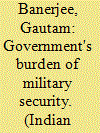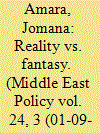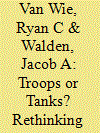| Srl | Item |
| 1 |
ID:
146573


|
|
|
|
|
| Contents |
It needs no revelation that there is widespread consternation within the strategically committed community, the intelligentsia and the media over the growing obsolescence and declining operational capability of the ultimate cutting instrument of national power - the military force structure. Thus in spite of maintaining the third largest military force in the world, there is imposition of only a fractional deterrence upon the perennial adversaries while they keep jabbing hurtfully at rib of the Indian nationhood. The new political leadership is apparently intent on remedying that undesirable situation. Therefore, to turn its rhetoric into action, the NDA government has to acknowledge that there are two distinct aspects to the amelioration of that undesirable stage, and tackled these on priority if its political pronouncements are to gain respectability from the citizenry.
|
|
|
|
|
|
|
|
|
|
|
|
|
|
|
|
| 2 |
ID:
155562


|
|
|
| 3 |
ID:
186971


|
|
|
|
|
| Summary/Abstract |
Are some conventional military units better equipped to conduct counterinsurgency (COIN) operations than others? COIN theorists and practitioners disagree about mechanization’s impact on COIN effectiveness. We suggest that mechanization is not the critical determinant of COIN effectiveness. Rather, mechanization’s effects vary based on a unit’s force employment approach within local scope conditions. To test our hypothesis, we explore how mechanization impacts COIN operations in Ramadi and Basra and find that force employment is the critical determinant in COIN effectiveness. We introduce an adaptive force employment hypothesis that outlines how mechanization includes costs to exposing dismounted troops and benefits in information-sharing, conditional on local insurgent strength. This hypothesis suggests that mechanized forces provide significant benefits to counterinsurgents when clearing high strength insurgents, outweighing benefits from dismounted civilian interaction. Following successful clearance operations when government control is increased and insurgent strength is reduced, requirements for armored protection decrease while civilian tips become increasingly important to target remaining insurgents. In the hold and build stages, counterinsurgents can increasingly rely on dismounted troops.
|
|
|
|
|
|
|
|
|
|
|
|
|
|
|
|